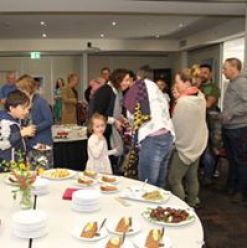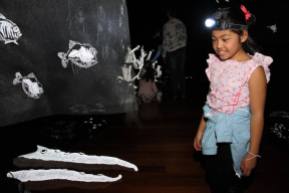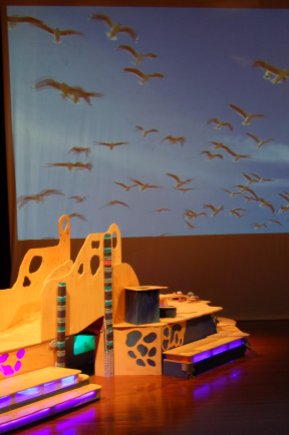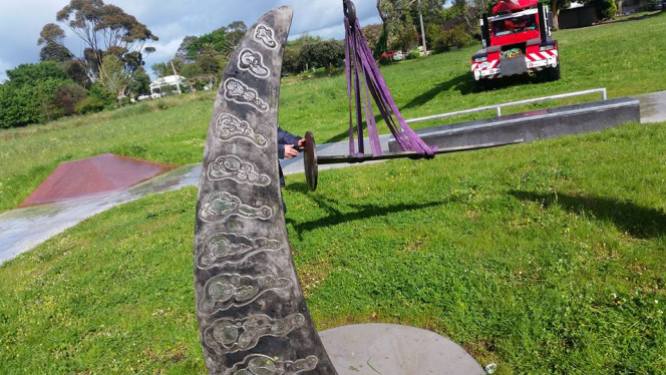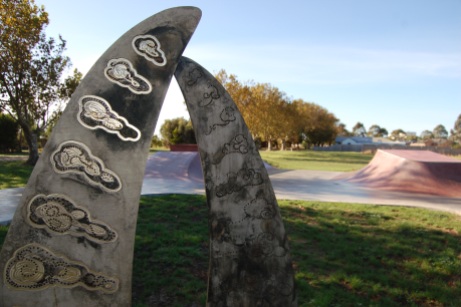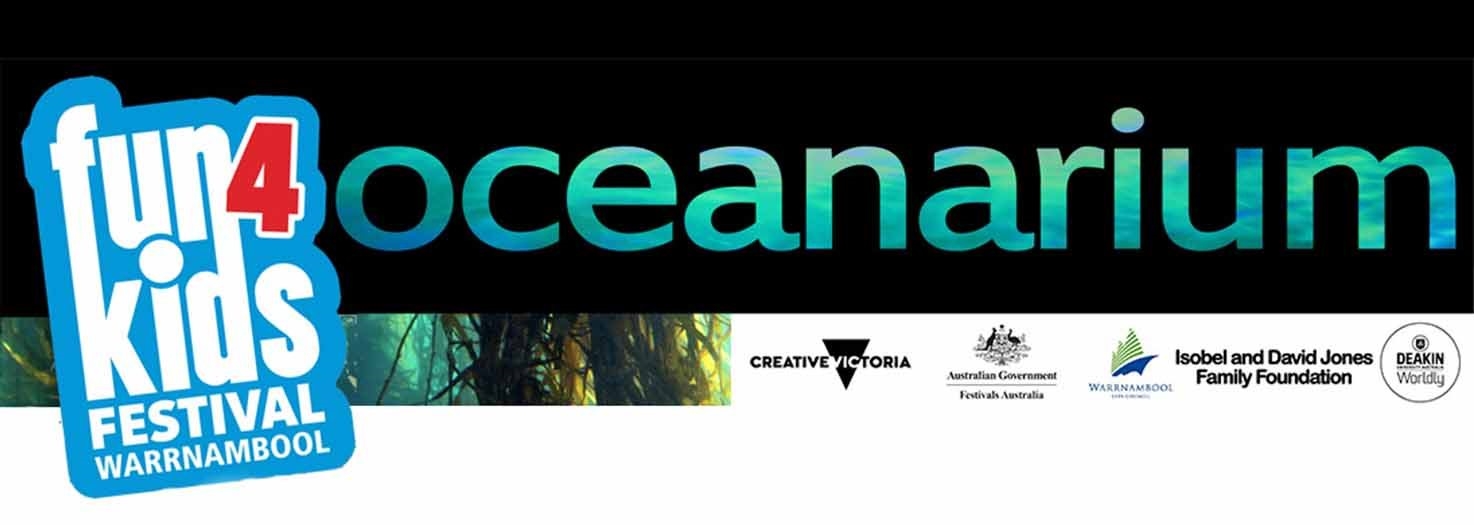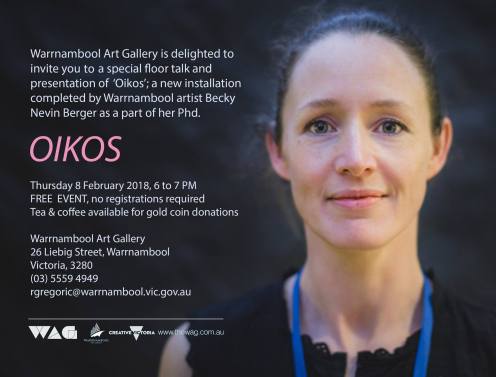
Sometimes you get the sense of synchronicity pulling things together. There were many times during my PhD research project in which that sense was absent, thankfully during the final months a shift occurred and it felt like the universe was back on my side. In late November last year I caught the train to Melbourne for some R&R after completing drafts of what I thought were the second and third chapters of my exegesis. I sat, quite fortuitously, next to another artist Kim Sargent-Wishart. I had heard of Kim but we’d not yet met. This was a very happy accident. During our conversation she suggested that I talk to Ren Gregoric at the Warrnambool Art Gallery about testing some of my installation ideas publically. At this stage in my creative practice-led research I knew what my final artwork needed to be however I was not sure what its final form would look like in the physical world. I needed to play with the work out in the open.
I met with Ren in early January. It was clear that he was pragmatic. Ren’s approach was very much based around “how can we make that happen”, he is an enabler in the very best sense of the word and exactly the person that I needed at that point in my project. By the end of that week Ren had a date proposed for me to come in and test out some ideas in conversation with him, and a second date booked for me to publically test these along with presenting a floor talk about my research.
Over the course of my research I had worked toward refining the multiple tangents of my studio based research into a singular, cohesive installation that communicated the complexity of the body’s connection with the environment. For much of my research the pathway for doing this was illusive, however I trusted that the creative process would yield the beautiful and transformative aesthetic culmination that it always does.
Water had become an important metaphor for capturing the many different forms and layers of the body’s connection with its environment. In particular, the quote from Marily Cintra (CraftACT, 2012) “do we realise that when turn on a tap in Canberra we are diverting the river into our homes” became a crucial catalyst. Through making artworks and observing my domestic space and its relationships to the surrounding landscape and urban infrastructure it became clear that we continually draw resources into our homes to furnish the comfort and stability of their interiors. These processes of domestic space making enable us to manage the continual entropy which all things are subject to: through cleaning, mending, restocking, and tidying we delay the appearance of decay and generate order; this constant movement generates the comforting sense of the home’s internal stability.
Over the course of my research I came to represent this domestic space making in a series of small boxes covered with textures and images relative to the experience of the home’s interior.

There is a long story attached to the process of developing these boxes into the final installation… the short story is that in conjunction with reading Yuriko Saito’s everyday aesthetics one evening the image of a river comprised of these small boxes emerged in my mind. Concurrent with the modernisation of Australian homes and family life through new hygiene and cleaning practices, among other things, was the development of the landscape – in particular the Australian dam building project which saw rivers and wetlands dammed to provide the clean water that could service the needs of our growing urbanisation. A river comprised of my little handmade domestic worlds would enable me to describe that inversion of the natural environment required to make the interior worlds of our homes.
I had attempted a few approaches for creating this river which included suspending these boxes from fishing line as well as projecting video through them…
I couldn’t quite get a buzz off these approaches though. This was where talking things through with Ren and testing my ideas in the Warrnambool Art Gallery was crucial. I laid the little boxes out on the gallery floor and Ren asked what it was that I most wanted people to see, my answer: a river. Ren suggested that bringing the boxes up to eye level whilst anchoring them to floor rather than suspending them. He prompted me to really think about what any new material would bring to the reading of the work. I had three days to work out a solution. I wandered through the hardware store puzzling over the different approaches I could take, finally I came upon PVC plumbing pipe and I felt a click in my imagination. I bought several lengths and began to experiment in my back yard.
It was really important that I create a sense of fluidity through the boxes as I arranged them on the PVC stilts which would form the base of my river.
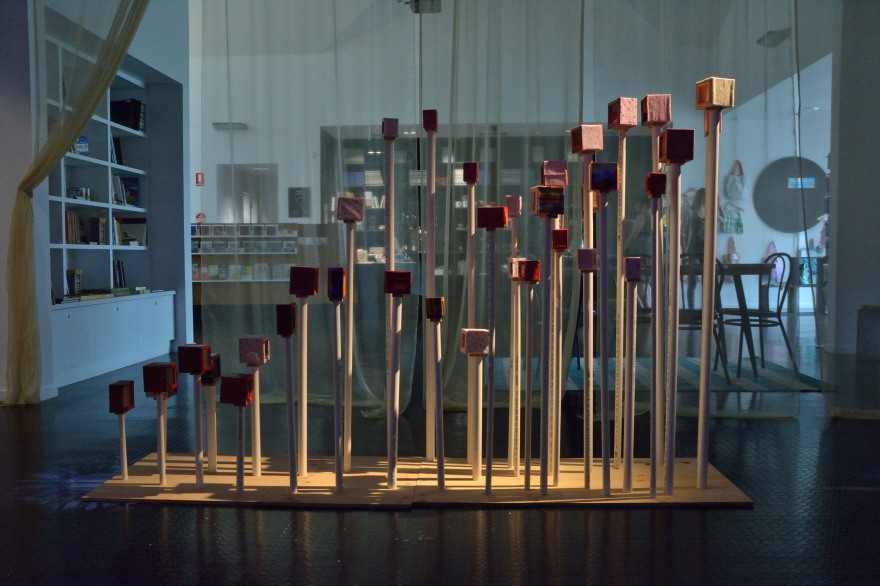
The next step was to bring this into the gallery space. A lovely little crowd turned up for my artist talk. My good friend and photographer Brendan Kelly recorded the work for me. It was really nice to share the story of my research project, the loveliest moment was hearing an audience member say “that makes sense!” as I concluded – there are possibly no greater words to hear when you are in the final stages of writing your exegesis.
The installation was accompanied by the sound of my washing machine. I had first used this sound recording in my video installation work Inside Out (2014). The sound had come to represent the flow of water through the house along with the cleaning practices through which the space is maintained. The particular recording I captured included the sound of the washing machine spinning out of balance- the presence of entropy emerging within the very processes used to keep entropy at bay.
I finally felt like the work was close. As I packed my work up Ren prompted me to think about the PVC Pipes and the way they connected to the work- how might I use them to bring more fluidity into the work? How might I build on that notion of “truth to materials”.
At this stage in my PhD I was in the final stage of writing my exegesis. Returning home from my writing refuge late one evening the final form crystallised in my imagination.
The idea that the work should be a river had persisted since early 2017. During that time I had wondered which river it should replicate- the Gellibrand River from wherein Warrnambool takes its water supply? the Mitta Mitta or Murray Rivers from my childhood terrains? Perhaps the Merri River that flows through my neighbourhood?
Considering these questions as I sat on my coffee table and I became aware of “the river” that had sat within my research and my imagination since I had first began thinking about domesticated water in 2013. This “river” had sat off to the right of my minds eye throughout the research and not until that point actually moved into my focal awareness. In a subtle way I had always imagined the river diverted through my home beginning at my kitchen tap exiting through my bathroom ensuite. I realised that this was the river that I needed to make, one that followed these dimensions.
I began with a very loose draft mapped out in the materials I had at hand. I felt excited by the potential of the work that needed to be made. I also felt terrified by the prospect of attempting to complete it to the full potential of what it needed to be.
The completed form would be created almost a month later after the exegesis was submitted and I had amassed the armoury of PVC pipes and attachments required. The process was a particular kind of magic.



























